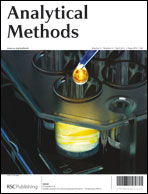Flow injection analysis for nitric oxide quantification based on reduced fluoresceinamine
Abstract
A fluorescence flow injection analysis (FIA) methodology for nitric oxide (NO) quantification was optimized by factorial analysis for the lowest limit of detection of nitric oxide. This methodology is based on the reaction of the NO with the non-fluorescent reduced fluoresceinamine given a high fluorescent oxidized fluoresceinamine. Box–Behnken and central composite optimization experimental design methodologies were used. The factors initially analysed by a screening experimental design methodology were the flow rate of the pump (Q), loop volume (L), reactor length (R), reduced fluoresceinamine concentration (CFl) and cobalt chloride concentration (CCoCl2). The response variables under analysis were the maximum fluorescence intensity, response repeatability and peak width. The optimum conditions were: one flow stream FIA configuration, Q = 0.60 mL min−1, L = 100 μL, R = 2 m, CFl = 1.50 mM and without CoCl2. A linear working range between 5 to 40 μM was evaluated with a limit of detection of 1.20 μM.


 Please wait while we load your content...
Please wait while we load your content...